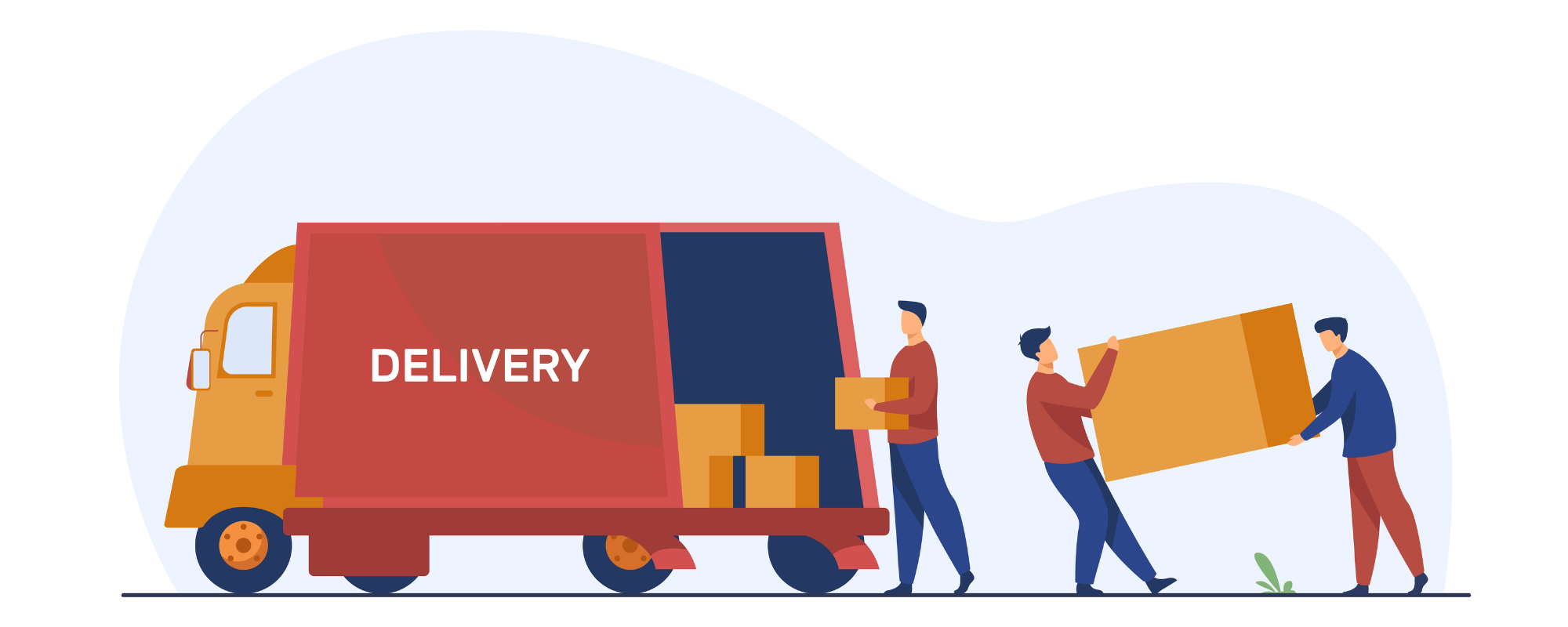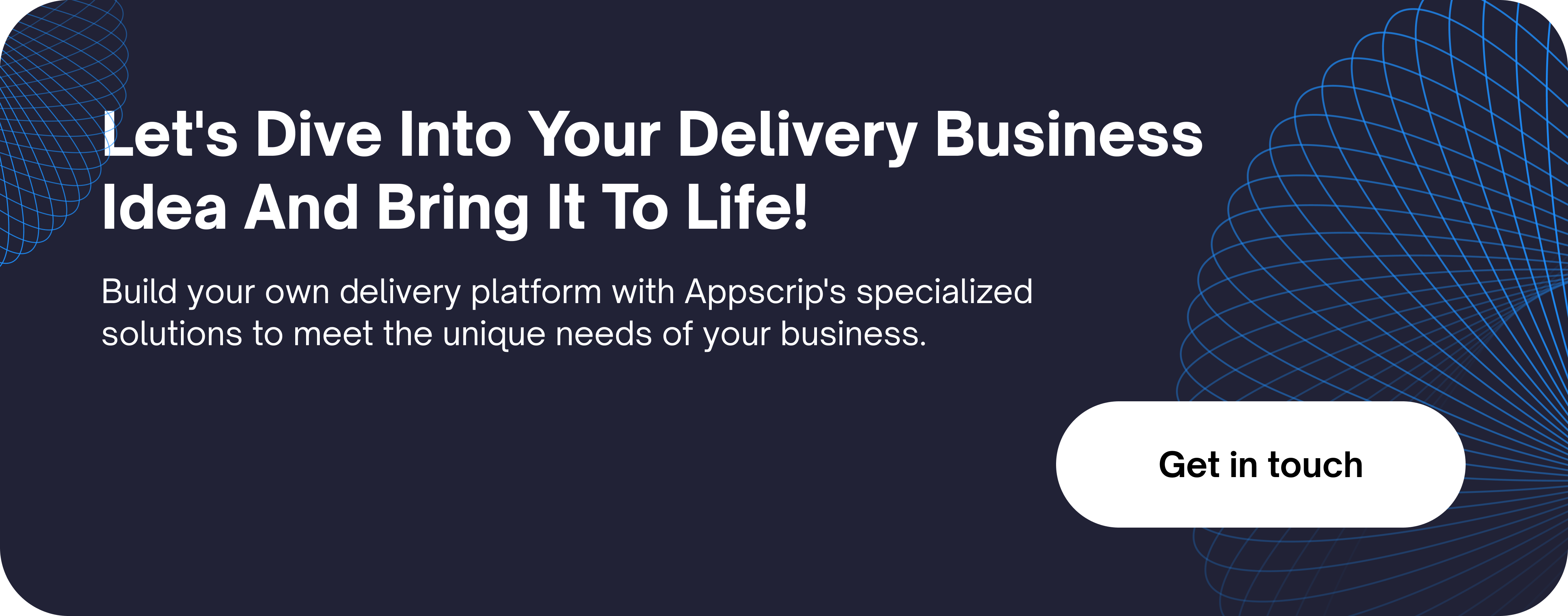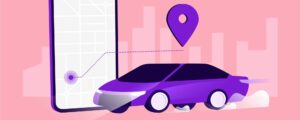In the era of e-commerce dominance, last mile delivery apps have become indispensable tools for businesses striving to provide efficient and seamless delivery services. Leading players in this space, such as UPS, Fedex, USPS, OnFleet, and others have revolutionised the way packages are delivered.
In this blog, we shall deduce the cost of developing a last mile delivery app like OnFleet so that entrepreneurs aiming to foray into this domain know their numbers.
Cost Of Developing A Last Mile Delivery App Like OnFleet
| Type Of App | Timeline | Cost | Functionalities |
| Simple app with basic features | 4-6 months | $20,000-$50,000 | User registration, order placement, real-time tracking, and basic notifications |
| Uncomplicated app with extensive features | 6-9 months | $50,000-$100,000 | Advanced route optimisation, multiple delivery options, feedbacks, payment integration, and administrative dashboards |
| Highly complex app with complex features | 9-12 months | $100,000-$200,000 | Sophisticated dispatching algorithms, multi-platform support, API integrations (mapping, payment gateways), analytics and reporting, and customised features |
Factors Influencing the Cost of Developing a Last Mile Delivery App
- App Design and User Experience (UX)
App design and user interface (UI) are key to attract and retain users. The design should be uniform, responsive across devices, and optimised for use.
- User interface (UI) design
The complexity and quality of the user interface design will impact the development cost. A well-designed and intuitive UI may require more effort and expertise, thus increasing the cost.
- App branding and customisation
If you are aiming to brand and customise your app to align it with your company’s identity, it may add to the development cost.
- User experience testing and optimisation
Conduct thorough user experience testing and implement optimisation measures to enhance the app’s performance but this may require additional resources and time, impacting the cost.
Development Approach
- Native vs. Cross-platform app development
Choosing between native and cross-platform development depends on your target platforms and desired app performance. Native development tends to be more expensive.
- Backend infrastructure and scalability
The complexity and scalability requirements of the app’s backend infrastructure can influence the cost. Building a robust and scalable backend involves additional development effort and infrastructure costs.
- Technology stack selection (PLs, frameworks)
The choice of PLs, frameworks, and other technologies can impact the development cost.
App Complexity and Customisation
- Number of user roles and their functionalities
- Integration with third-party APIs and services
- Custom feature development based on unique business needs
Development Team and Resources
- Hiring in-house vs. outsourcing
- Skillsets required (App developers, UI/UX designers, backend engineers)
- Project management and quality assurance
Ideal Tech Stack While Developing An App Like OnFleet
Frontend:
- HTML5/CSS3
- JavaScript (ES6+)
- React.js
- Redux
- Axios
- React Router
- Responsive Design Framework: Bootstrap or Material-UI
Backend
- PL: Node.js or Python
- Framework: Express.js (Node.js) or Django (Python): backend APIs
- ORM/ODM: Mongoose (Node.js + MongoDB) or SQLAlchemy (Python + PostgreSQL) for object-relational mapping
DevOps
- Deployment: Docker for containerisation
- Orchestration: Kubernetes for managing containers
- Continuous Integration/Continuous Deployment (CI/CD): Jenkins or GitLab CI/CD for automated testing and deployment
- Cloud Platform: Amazon Web Services (AWS) or Google Cloud Platform (GCP)
Architecture
- Microservices Architecture
- Event-Driven Architecture using a message broker like RabbitMQ or Apache Kafka
App
- Cross-Platform Development: React Native or Flutter
- State Management: Redux or MobX for managing app state
- Real-time Updates: WebSocket or Socket.IO
| Website | Frontend Framework: React.js or Angular ; Responsive Design: Bootstrap or Material-UI |
| Database | MongoDB or PostgreSQL ; Use database indexes and caching mechanisms |
| Real-time Chat | WebSocket or Socket.IO ; Message broker like RabbitMQ or Apache Kafka |
| Calling | WebRTC ; Twilio API |
| Push Notifications | Firebase Cloud Messaging (FCM) and Apple Push Notification Service (APNs) |
| SMS | Twilio API or Nexmo |
| SendGrid or Nodemailer | |
| Payment Gateway | Stripe or Braintree |
| Geolocation | Google Maps API or Mapbox API |
| Analytics and Crash Reporting | Google Analytics or Mixpanel ; Crashlytics or Sentry |
Cost Breakdown and Budgeting for Last Mile Delivery App Development
App Development Costs
- Design and UX/UI development
The cost may vary depending on the complexity of the app, the number of screens and features, and the level of customisation required.
- Frontend and backend development
The cost will depend on the technology stack used, the complexity of the app’s features, and the development time required.
- Third-party API integrations
The cost will depend on the number and complexity of the integrations required.
- Quality assurance and testing
It involves manual testing, automated testing, and user acceptance testing. The cost will depend on the size and complexity of the app, as well as the testing methodologies employed.
Maintenance and Support Costs
- Server hosting and infrastructure maintenance
Servers and infrastructure are required to handle user requests, store data, and ensure smooth app performance. The cost will depend on the app’s expected user base, server requirements, and hosting provider.
- Bug fixing and performance optimisation
Over time, bugs and performance issues may arise that require fixing and optimisation.
- Feature updates and enhancements
As technology evolves and user needs change, it is essential to update the app with new features and enhancements.
Additional Costs and Considerations
- App store submission and developer account fees
To publish the app on Google Play Store or Apple App Store, there’s fees associated with developer accounts which vary depending on platform and region.
- Security and data privacy measures
Costs may include implementing encryption, data protection protocols, and complying with relevant regulations and standards.
- Marketing and user acquisition costs
Marketing efforts to promote the app, acquire users, and increase app visibility. The cost will depend on strategies employed, such as digital advertising, influencer partnerships, or content creation.

Understanding the Scope and Features of a Last Mile Delivery App
Core Functionality
Customer App Features
The customer app is designed to provide a user-friendly interface for placing orders and tracking deliveries. It typically includes:
| Functionality | Details |
| Start A Booking | Carriers can track active loads, review their pickup time, and hit start |
| Select Commodity | Choose the commodity of your load from options and view trucks |
| Select Packaging Type | Shippers to select packaging type and enter load specifications |
| Load Details | Shippers can review the details before proceeding further |
| Collect Payment From Receiver | Shipper can communicate payment will be paid by the receiver |
| Truck Details & Fare Estimation | Shippers can review the truck details and fare breakup |
| Select Payment Method | Shippers may choose their mode of payment |
| Add Stops | Shippers may add multiple stops for unloading / delivery of goods that maybe picked from a single location |
| Live Tracking | Shippers can track the status of their booking after confirmation |
| My Loads | Shippers may check load details and track status of all bookings |
Driver App Features
The driver app is an essential component that empowers drivers to efficiently manage their assigned deliveries. Key features include:
| Functionality | Details |
| Arrive To Pick Up | After carrier reaches the pick up location, they can update status |
| Load Details | Carriers can view the load details they have accepted |
| Stop Details | Carriers can view the number of stops and its details |
| Start Loading | As the loading begins, the carrier can update the status |
| Loading Timer | A timer will start to record the time taken for loading |
| Proof Of Pickup | The carrier needs to upload the proof of pickup after loading completes |
| Arrive To Deliver | Once the carrier reaches the delivery location, status can be updated |
| Unloading Timer | After the unloading starts, a timer will start to record unloading time |
| Proof Of Delivery | The carrier needs to upload the proof of delivery after completion |
| Automated Invoice | As soon as the proof of delivery is uploaded, the booking is completed and an automated invoice is generate |
Central Dispatcher
Bird’s View
This is the overall view of the status of every booking that is ongoing, scheduled, or completed along with the details of all the available and unavailable drivers
Book A Truck
This allows the dispatcher to create a booking on behalf of the customer and resolve any issue that might be arising at the customer’s end
Assign/Unassign Driver
The dispatcher can assign or unassign bookings for carriers available for the area of a booking
Load Details
The load details of any booking can be viewed in the dispatcher panel by the dispatcher whenever required
Advanced Features and Integrations
- Advanced Analytics and Reporting
Last mile delivery apps can incorporate advanced analytics and reporting features for operational efficiency. Therefore, businesses can track key metrics, evaluate performance, and make data-driven decisions.
- API Integration with Existing Systems
Integrations with CRM software, inventory management systems, or enterprise resource planning (ERP) tools, enhances operational efficiency, and streamlines data flow between various platforms.
- Inventory Management and Order Fulfilment
Last mile delivery apps can integrate inventory management systems to provide accurate stock availability information, allowing businesses to optimise order fulfilment and reduce instances of stock-outs.
- Customer Support and Feedback
To ensure customer satisfaction, last mile delivery apps can offer features for seamless customer support, including in-app chat or messaging options, as well as feedback mechanisms for users to rate their delivery experiences and provide valuable feedback.
- Integration with Third-Party Services (payment gateways, maps)
Integrating with payment gateways, mapping services, or SMS gateways, expands the app’s functionality, and enhances user experience.
Conclusion
The cost of developing a last mile delivery app like OnFleet requires careful consideration of the core functionality and advanced features necessary to meet the demands of customers and streamline operations.
While the cost of developing a last mile delivery app like OnFleet can vary based on factors like app complexity, platform choice, and desired features, understanding the scope and key components can serve as a foundation for estimating the development cost.
Our product Shypr, a last mile software solution is an apt product for entrepreneurs foraying into this domain. It possess marquee features such as: Single Pickup & Multiple Drop: option for shippers to choose LTL loads for pickup from a single location and drop to multiple locations.
Route Optimisation: routes are automatically optimised in case of multiple stops to enhance efficiency of delivery and save time. Enterprise Account: Shypr offers a dedicated platform for customers who usually do bulk loads and pay using their credit line.

After an Engineering degree and a Diploma in Management I devoted 16+ years working in the automotive industry. My innate skill and extreme passion in writing, encouraged me to adopt it up as a profession. I have been writing for more than 10+ years in the software industry. The 400+ blogs I published are informative, exhaustive and interesting to a professional and causal reader.









